|
|
Army Units Station Hospitals:
|
|
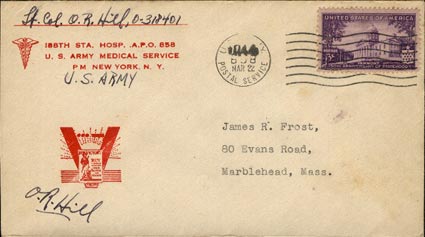
Preprinted envelope from Lt.Col.
Hill, 188th Station Hospital in Narsarssuaq. 22.3.1944
Passed by Army Examiner
|
|
|
|
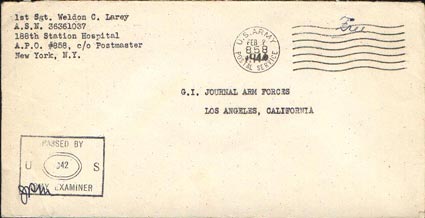
188th Station Hospital (APO 858 - Narsarssuaq) 2.2.1944 - #942
188th Station Hospital
|
Location |
|
Base Code |
Size |
Operation |
|
Narsarssuaq |
N61 11 W45 25 |
BW1 |
250-bed hospital |
(Sept 42) - (1945) |
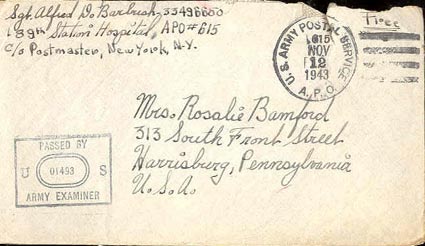
189th Station Hospital (APO 615 -
Ivigtut) 12.11.1943 - #01493
189th Station Hospital
|
Location |
|
Base Code |
Size |
Operation |
|
Grondal/Ivigtut |
N61 13 W48 07 |
BW7 |
25-bed hospital |
(Sept 42) - Aug 1944 |
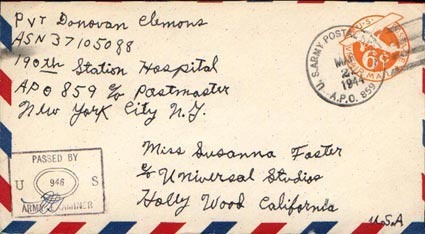
190th Station Hospital (APO 859 - Sondre Stromfjord) 22.3.1944 - #946
190th Station Hospital
|
Location |
|
Base Code |
Size |
Operation |
|
Sondre Stromfjord |
N67 02 W50 40 |
BW8 |
200-bed - reduced to a |
(Sept 42) - (1945) |
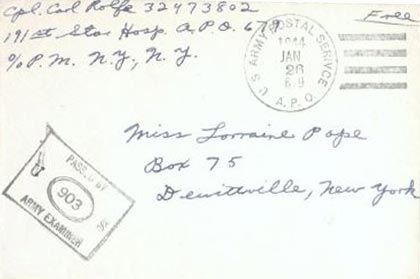
191st Station Hospital (APO 679 - Ikateq) 26.1.1944
|
Location |
|
Base Code |
Size |
Operation |
|
Ikateq |
N65 56 W36 41 |
BE2 |
150-bed - reduced to a |
(Sept 42) - (1945) |
|
Greenland Base Command After months of indecision, officials of the State, War, and Navy Departments agreed early in February 1941 that airfields and other facilities in Greenland would be needed for hemisphere defense, and that in view of the Monroe Doctrine the United States could permit no other power - not even friendly Canada - to take the initiative there. A survey expedition sailed in March. Less than a month later, on 9 April, the project received formal sanction when the Danish Minister in Washington (still recognized by the United States) and the Secretary of State signed an agreement under which the United States guaranteed the security of Greenland in return for the right to construct, maintain, and operate the required facilities. The first echelon of the Greenland force - 469 officers and men - sailed from New York on 19 June and anchored off Narsarssuak on the southwest coast of Greenland on 6 July.* In addition to its responsibility for the health of Army and Air Corps personnel and employees of civilian contractors stationed there, the Medical Department in Greenland supplied hospital facilities for the crews of Navy, Coast Guard, and merchant vessels and of transient aircraft. A small detachment of Medical Department officers and enlisted men arrived with the first contingent at Narsarssuak, where the first U.S. military post, BLUIE WEST 1, was established. In August 1941 the medical detachment there set up a 10-bed field-type tent hospital, which operated for two months before a suitable building could be erected. A 5-wing cantonment-type building was eventually built. The wings were connected by heated corridors. Supply rooms and the mess hall were off the main corridor, opposite the clinic and hospital wings. Initially, only one wing with twenty beds was required for inpatients. It was not until January 1943, when survivors from the torpedoed USAT Dorchester were brought to BLUIE WEST 1, that two other wings were made ready, expanding capacity to approximately sixty beds. In October 1941 a post was established at the head of Søndre Strømfjord on the west coast of Greenland about fifteen miles inside the Arctic Circle. Known as BLUIE WEST 8, this post was under command of the famed arctic explorer, Capt. (later Col.) Bernt Balchen, with Maj. (later Col.) John R. McBride as surgeon. BLUIE WEST 8 included civilian construction workers, who had been there since September, and Army engineers. The engineer medical officer, Capt. (later Lt. Col.) Stephen W. Ondash, was responsible for the health of the civilians. The first hospital set up on the post, an engineer unit available to all, opened on 10 December 1941. In November a post was established at Angmagssalik on the eastern coast of Greenland about forty miles below the Arctic Circle. BLUIE EAST 2, as the new post was called, was primarily a weather and communications station. It included a medical officer and an engineer dispensary operated by civilians. In March 1942 a post was set up at Ivigtut, about 100 air miles west of Narsarssuak, where the cryolite mine was located. The Ivigtut base was called BLUIE WEST 7. By June a small building had been erected for a dispensary. The Greenland Base Command, with headquarters at BLUIE WEST 1, had meanwhile been formally activated on 26 November 1941, although Army forces in Greenland had been using that designation since their arrival. There was no surgeon for the whole command, however, until November 1942, when Colonel McBride, as the senior Air Forces medical officer on the island, was assigned that responsibility. He was succeeded in March 1943 by Maj. (later Col.) Norman L. Heminway, commanding officer of the 188th Station Hospital and surgeon of the BLUIE WEST 1 base. In December Colonel Heminway was transferred, being succeeded in each of his three capacities by Maj. (later Lt. Col.) Otho K. Hill. Under War Department authority granted in September 1942, four numbered station hospitals were activated to replace the makeshift units then functioning. Cadres were drawn from Medical Department personnel already on the ground and actually operating the existing hospitals and dispensaries that were to be elevated to numbered status by the new arrangement. Authorizations were given for hospitals of 250, 200, 150, and 25 beds, for BW-1, BW-8, BE-2, and BW-7 respectively. Construction of buildings began in the fall of 1942, continuing into the late months of 1943. The bulk of the work was completed by the end of that year, when the troop build-up reached its maximum strength of about 5,300. The unduly long construction time was due in part to weather hazards, in part to low priority in a very restricted labor market, and in part to the necessity for importing all building materials from the United States. Largest of the hospitals, the 188th Station, opened at BLUIE WEST in its new buildings in December 1943. One of the finest examples of an overseas hospital, the installation was located for maximum terrain protection. It was built at a cost of $1,769,022. Its 32 cantonment-type buildings on 22.5 acres were connected by heated and insulated corridors. Central heating, electricity, running hot and cold water, and a modern sewage system made it a comfortable haven in the frozen wasteland of Greenland. The 188th Station, in addition to its function as post hospital, received patients from other units, mostly by air, who required further observation or treatment. It also acted as clearing and processing point for cases being evacuated to the United States. Additional hospital construction at the smaller posts in Greenland during 1943 made conditions less crowded, but bed requirements were never as great as had been anticipated. The 190th Station Hospital, originally authorized as a 200-bed unit, was reduced to a 50-bed hospital by the time it moved into its permanent quarters at BLUIE WEST 8. The 191st Station at BLUIE EAST 2 also operated as a 50-bed unit, although its original authorization had been for 150 beds. The smallest of the four Greenland hospitals, the 189th at BLUIE WEST 7, remained a 25-bed unit throughout its period of operation. At none of the four post hospitals was medical service seriously interrupted during the period of construction. New plants were occupied by echelon, as space became available, without closing down the old until the new was functioning. Such unavoidable curtailment of minor services as occurred was compensated for by treating as many cases as possible on a "quarters" basis. During the greater part of the year, transportation by water was very difficult or impossible. Therefore, each of the four main Army bases in Greenland had to be largely self-sufficient from the standpoint of supply. In practice this imposed no handicap as supplies for the base command as a whole were more than ample throughout the war. The months of isolation envisaged by the planners never materialized. In addition to the four bases themselves, there were a dozen or more weather observation and radio posts operating out of one or another of the BLUIES. For the larger outposts of this type a medical officer was provided; for the smaller, only a trained Medical Department enlisted man could be spared. Although the climate was much more severe and the setting far more bleak than anything the men had before experienced, there were no adverse effects on health. There were no indigenous diseases. The native Eskimos suffered heavily from tuberculosis, but contacts between the natives and the U.S. troops were so infrequent as to remove the hazard. The only venereal cases were among those who had been infected outside of Greenland. Respiratory diseases made up the largest item in the disease category, with newly arrived troops the most frequent victims. On the whole, however, the incidence of disease in Greenland was very low. Injuries, directly related to the treacherous and rugged terrain, ship loading and unloading, and construction work accounted for the largest number of patients admitted to hospitals, as well as about a quarter of all those evacuated to the zone of interior. The second largest group returned to the zone of interior, accounting for about 18 percent of the total, were the neuropsychiatric cases, stemming from the prolonged service in an isolated, unpleasant environment, combined with constant monotony and a complete lack of normal social contacts. A general apathy, called by the men stationed in Greenland, "The Arctic Stare," developed in a majority of troops after a years stay on the island. It was notable, however, that even in the most difficult year, 1944, neuropsychiatric cases constituted only about 4 percent of hospital admissions. The suicide rate was also relatively low. Admissions for all causes to the main hospital of the command, the 188th Station Hospital, numbered 1,821 in 1943 and 2,137 during 1944. Evacuation of patients within Greenland moved from the outposts to the main bases, where the permanent hospitals were established, and thence, if more elaborate treatment or ZI evacuation were indicated, to the 188th Station Hospital. Patients could be evacuated to the 188th from other parts of Greenland only by air and by sea, while those within BW-1 came in by bus or ambulance. Most of the patients sent to the zone of interior for further treatment were transported there by air; a few went by ship. Weather problems frequently complicated evacuation procedures in Greenland. Poor flying conditions or ice packs - which prevented the passage of ships - were responsible for many delays. Greenland Base Command sent an average of 15 to 25 patients a month to the United States for general hospital treatment. Beginning in 1944 the personnel of the 188th Station Hospital and the Air Transport Command fed and furnished professional services to transient patients being evacuated by air from Europe to the United States. From May to October, 471 such cases passed through the command, 34 of which were temporarily hospitalized. General reductions in strength during 1944 resulted in practically all ground force units being withdrawn from the command, leaving mostly air and service personnel. The base established to protect the cryolite mine at Ivigtut closed during the summer, and the 189th Station Hospital, which was located there, ceased operations in August. At the end of that month, Colonel Hill left the Greenland Base Command, being succeeded as post surgeon and commanding officer, 188th Station Hospital, by Capt. (later Maj.) John A. Jones, and as Greenland Base Command surgeon by Maj. Andrew W. Shea. Medical units operated below T/O authorizations when possible. Excess medical personnel and large amounts of surplus medical supplies were returned to the United States. Greenland Base Command had become primarily an Air Transport Command stopover and a weather forecasting center a year before the ATC assumed full responsibility for all U.S. activities on the island in January 1946. Only the hospital at BLUIE WEST 1 continued active at this time. * Sources for this section are: (1) Conn, Engelman, and Fairchild, Guarding the United States and Its Outposts, ch. XVII, ch. XX; (2) Craven and Cate, eds., Plans and Early Operations, pp. 122-23, 157-58, 342-48, 641-44; (3) Bernt Balchen, Corey Ford, and Oliver LaFarge, War Below Zero: The Battle far Greenland (Boston: Houghton Mifflin Company, 1944); (4) Annual Rpts, Med Dept Activities, Greenland Base Comd, 1941-44; (5) Annual Rpt, Base Hosp, Greenland Base Comd, 1946; (6) ETMD's (Essential Technical Medical Data), Greenland Base Comd, Jul 43-Nov 45; (7) Interv with Lt Col Otho R. Hill, 6 Sep 44; (8) Interv with Lt Col Norman L. Heminway, Dec 43; (9) Annual Rpts, 188th, 190th, 191st Sta Hosps, 1943-44; (10) Annual Rpt, 189th Sta Hosp, 1943; (11) Med Hist Rcd, Oct-Dec 44, app. E, AAF N Atl Wing, ATC; (12) Ltr, Norman L. Heminway to Col Goriup, 16 Aug 59; (13) Ltr, John R. McBride to Goriup, 28 Jul 59. Both letters comment on preliminary draft of this volume.From: THE MEDICAL DEPARTMENT: MEDICAL SERVICE IN THE MEDITERRANEAN AND MINOR THEATERS by Charles M. Wiltse (Washington D.C. 1965) |
Back to Greenland Units
Update: 8.3.2009
Feedback: warcovers@adslhome.dk